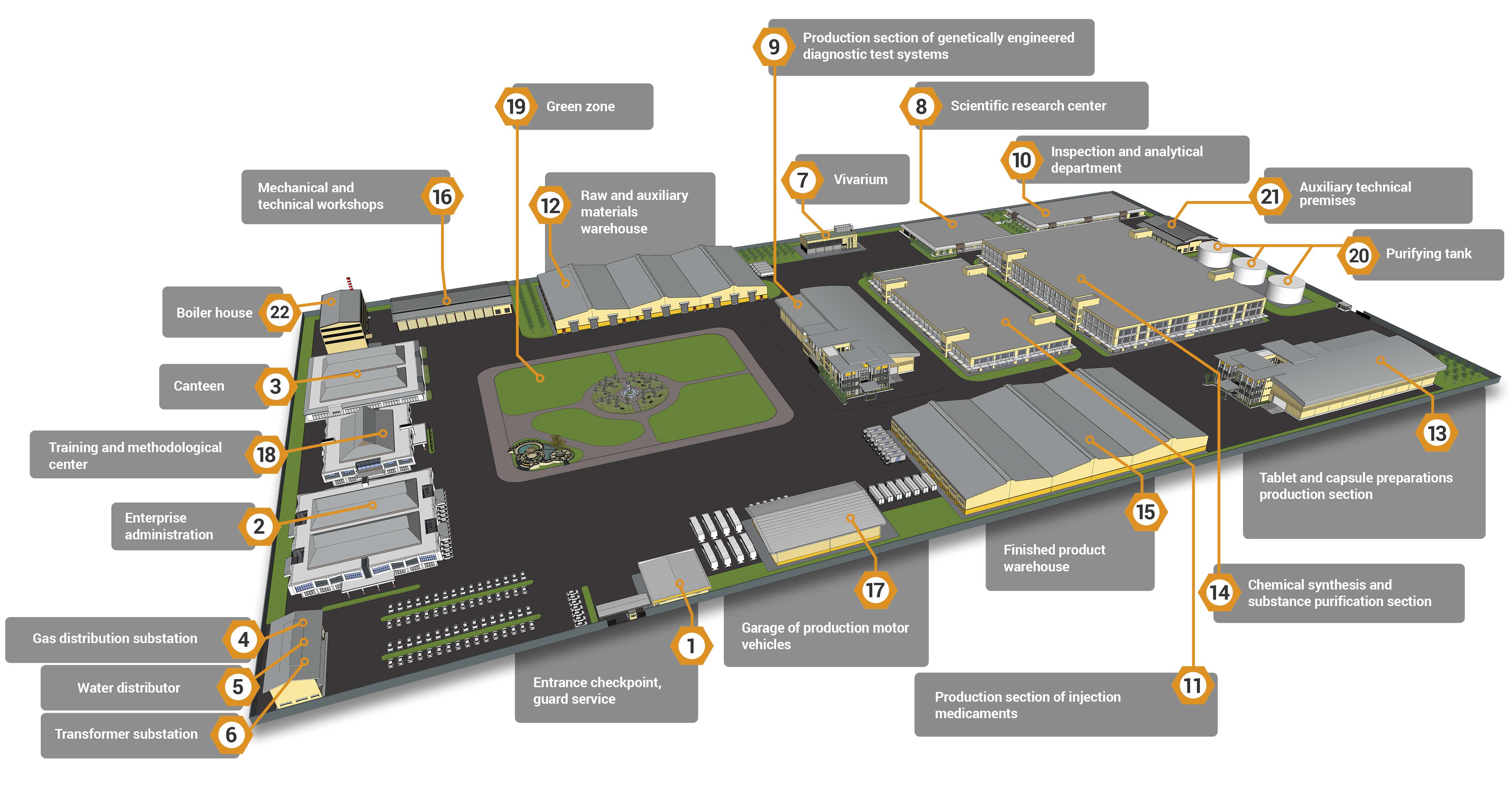Gorbiopharm
Gorbiopharm is an innovative technological pharmaceutical organization whose goal is to provide equal opportunity and access to healthcare for people. One of the missions of our organization is to work together with the World Health Organization (WHO). The WHO has various functions and goals, such as improving access to essential medicines and medical goods. The objective set by Gorbiopharm is to ensure the availability of such an important medicine as insulin, since the WHO reports constantly indicate that there is a shortage in its supply in developing countries. With Gorbiopharm’s innovative formula, people with diabetes around the world will benefit greatly as our partnership intention with WHO will help to plan and implement schemes and programmes to help developing and less developed countries.
In addition, Gorbiopharm is currently planning to work with the World Diabetes Foundation (WDF). WDF supports various activities and, like the WHO, works with the diabetes medicine providers. And in 2021, the foundation received over 17.5 million US Dollars in donations. Gorbiopharm is looking for ways to support the Children’s Diabetes Foundation (CDF), which is dedicated to supporting children and adults, diabetes research, and community awareness through education. The foundation was founded in 1977 and raised over 75 million US Dollars since 1978. The International Diabetes Federation (IDF) is another organization of interest to us. A non-governmental organization in official relationship with WHO, promotes diabetes prevention and care worldwide through knowledge sharing and collaboration, networking and political action.
There are various other foundations and organizations that exist to fight diabetes. And Gorbiopharm is constantly reviewing potential partners to expand the scope of future action. Thus, Gorbiopharm is a strategic open organization that plans to improve, support, and provide medical products at local and global levels.
PROJECT IMPLEMENTATION PLAN
2026

Architectural-construction and engineering-construction design of the enterprise
Start of foundation construction work
2027

Construction of main production buildings
Construction of main production buildings
Construction of auxiliary buildings
2028

Interior and exterior refinement
Completion of construction works
Equipment installation and commissioning
2029

Enterprise launch
Obtaining European ISO and GMP certificates
Obtaining European certificates for finished products
OUR KEY OBJECTIVES IN ACCORDANCE WITH THE WORLD HEALTH ORGANIZATION (WHO) GLOBAL DIABETES COMPACT
In 2021, the World Health Organization (WHO) launched the Global Diabetes Compact. The Compact aims to reduce the risk of diabetes and ensure that people around the world have access to equitable, comprehensive, affordable and quality treatment and care.
Throughout the foundation of the Compact, eight key areas were identified through expert discussions and collaboration with key stakeholders, including the United Nations (UN) agencies, insulin and diabetes healthcare technology providers, academia, civil society, and people with life experience with diabetes mellitus.
Gorbiopharm fully supports the Compact and strives to contribute to the observance of the principles and guidelines of the WHO.
UNITE
Bring stakeholders together around a common goal
There are already many opportunities to improve diabetes prevention and control, from changing risk factors to effective treatment and care. However, there is a lack of a common goal with clear objectives around which all stakeholders are united, taking action in their specific areas of expertise.
INTEGRATE
Integrate diabetes prevention and treatment into primary health care and universal health insurance
In many countries, services for prevention, diagnosis and treatment of diabetes, including screening for complications, do not exist at the primary health care level or cannot be accessed free of charge. Also, in many parts of the world, diabetes medicaments are not included in health insurance schemes and cannot be purchased without financial hardships. Growing prevalence of diabetes and other non-communicable diseases is a serious problem. However, integrating diabetes prevention and care into primary healthcare system and universal health insurance could be a significantly beneficial solution.
INNOVATE
Close research and regulatory gaps, by driving innovation
The WHO Compact aims to address priority research gaps. The Compact will promote innovation, including development and evaluation of low-cost technologies and digital solutions for diabetes treatment, with a focus on helping the most vulnerable populations.
TREAT
Improve access to diabetes diagnostics, medicines, and goods for health, especially insulin, in countries with low and middle level of income
Many people struggle to access affordable medicines and technologies to treat diabetes. Improving access requires efforts from public and private sectors. The WHO is working to identify ways in which these sectors can help solve problems in a meaningful way. For example, by increasing transparency, guaranteeing an uninterrupted supply of insulin to low-income countries and countries with humanitarian emergencies, participating in future procurement mechanisms, and participating in the WHO insulin prequalification program.
TRACK
Develop global coverage targets for diabetes care
Setting global coverage targets can stimulate action to improve access to care for people with diabetes. Given that many people are currently living with diabetes without even realizing it, the goal of global coverage of these people is vital. Investing in combating diabetes can be cost-effective and equitable. Conversely, inaction leads to significant costs that could have been avoided. An explanation of the links between strengthening health systems and economic growth, as well as the economic benefits offered, is needed to justify investment action. Accordingly, this objective will aim to quantify costs and benefits of narrowing the gap between people who can access to the diabetes care services and those who cannot.
FUND
Improve diabetes treatment for those experiencing humanitarian emergencies
Several million people with diabetes have been affected by humanitarian emergencies. And these people face unique challenges. For them, access to essential medicines and diagnostics is often lacking or insufficient. Development and implementation of activities in cooperation with humanitarian partners should hence be a priority.
EDUCATE
Improve understanding of diabetes
There is a need to improve understanding of diabetes and how it can be prevented and treated. It is essential to expand health education and literacy at community level. To, for instance, explain and educate signs and symptoms of diabetes, nuances of diabetes, or available interventions.
POWER AHEAD
Ensure a better recovery based on the experience of the COVID-19 pandemic
If not addressed immediately, diabetes threatens existence of families, resilience of national health systems, and global growth and development. The COVID-19 pandemic is putting additional pressure on these threats and will have long-term impacts on health and healthcare systems vital to rehabilitation and care. Thus, recovery from the COVID-19 pandemic must go hand in hand with action to combat diabetes.
PROGRAM OF THE WORLD HEALTH ORGANIZATION (WHO)

At a special ceremony in the United Nations (UN) Headquarters in Copenhagen in November 2021, the day after World Diabetes Day, the World Diabetes Fund (WDF) signed an agreement to provide the World Health Organization (WHO) with over 900,000 US Dollars for a three-year project to support efforts to prevent and control non-communicable diseases through primary healthcare aid in Uzbekistan and Kyrgyzstan. The main beneficiaries of this project will be people with diabetes, their families and caregivers, and especially those most in need.
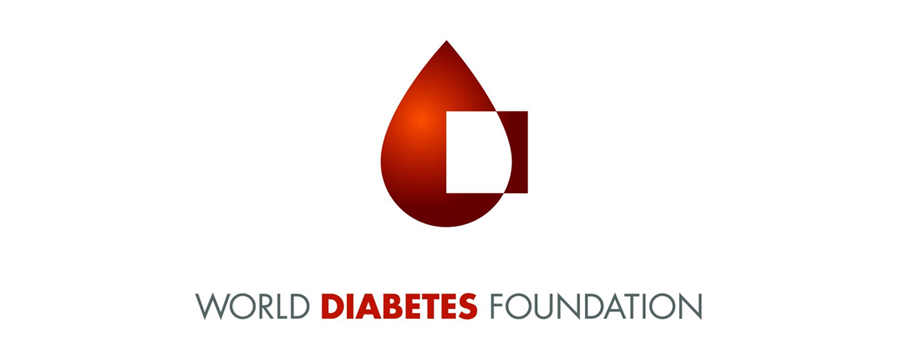
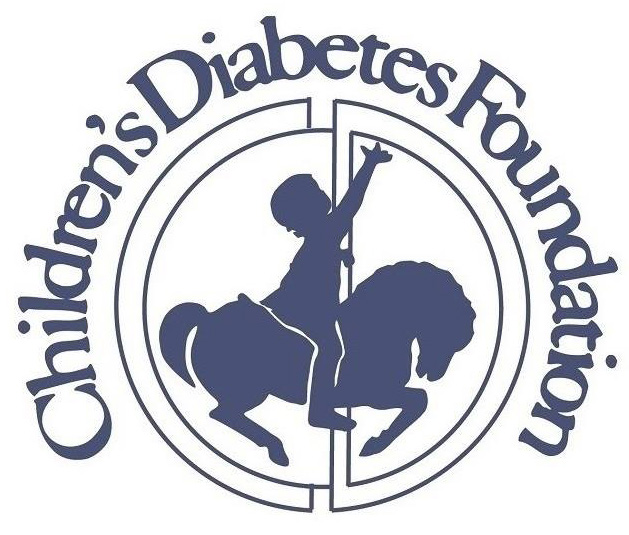
"GREEN"
INSULIN MEANS - "HALAL" INSULIN
In emerging markets, "introducing blockbuster insulin organizations" may not always bе аn effective strategy. For example, in some target markets, the islamic population represents а significant number of people, and religion dominates public opinion. In this regard, availability of so-called "halal" insulin (which means "religiously" pure preparation of non-animal or bacterial origin) is а very important factor.
So far, the UAE and other countries in the Middle East had to import most of their diabetes medicaments. Thus, governments in these regions are interested in attracting drugs from foreign manufacturers who recognize the importance of local traditions and cultures. Gorbiopharm, in turn, is planning to manufacture human insulin from genetically engineered plants.
BUSINESS STRATEGY
While the epidemiology of diabetes and the unmet need to increase supply of insulin mean that there are multi-Ьillion-dollar opportunities, success of entering the mature insulin market is still highly controversial. Today, biosimilar producing companies face signif1cant regulatory, commercial, and competitive challenges to enter the market. Given these obstacles, complexity and cost of producing insulin, it is unlikely that numerous biosimilars will appear оn the insulin market in the near future.
Gorbiopharm is going to focus mainly оп smaller markets. Today, the most of insulin biosimilar companies are targeting mature markets at the expense of emerging markets, based оn assumptions about where the greatest return оп investment саn bе achieved.
Gorbiopharm believes that the most realistic and viable market entry strategy is to succeed in emerging markets through adaptation to local conditions, rather than through success in а mature market. In these markets, insulin remains unaffordable. And according to studies, these markets will account for almost 80% of the global diabetes market Ьу 2030. Thus, the dynamics of products introduced to emerging markets for the first time is assumed to Ье more flexible than in developed markets.
CREATION OF A HIGH-TECH BIOPHARMACEUTICAL COMPLEX FOR THE PRODUCTION OF GENETICALLY ENGINEERED MEDICINES
“Improving public health is our top priority.”
The President of the Republic of Uzbekistan
Shavkat Miromonovich Mirziyoyev
DIABETES IS A GLOBAL EMERGENCY
Diabetes is one of the biggest global health emergencies of the 21st century. And it reached pandemic proportions. The International Diabetes Federation (IDF) estimates that in 2021, 536.6 million people worldwide had diabetes, and the disease accounted for more than $966 billion in global healthcare spending. The IDF estimates that in 2045 there will be 783.2 million diabetic patients worldwide and healthcare costs of US$1.054 billion.
According to the same estimates, diabetes is the third leading cause of death after cardiovascular diseases and cancer. In 2021 only, about 6.7 million deaths worldwide were directly attributable to diabetes. This is equivalent to one death every eight seconds and is estimated to be associated with 12.2% of global deaths from all causes among the world’s population. More than 80.6% of deaths occur in middle- and low-income countries.
Given significant therapeutic value of insulin, all manufacturers still lack production capacity to meet the demand and ensure adequate and stable supply. As estimated, 60-65 million people do not have access to this life-saving medicine, which is an essential and urgent need. Universal availability of insulin for people with diabetes is seen as a basic human right, but almost a century after its discovery, insulin remains largely unavailable, expensive, or both. To date, the coverage of the need for insulin in the world is about 18-20%.

Number of people with diabetes worldwide and by IDF region 2021-2045 (20-79 years)

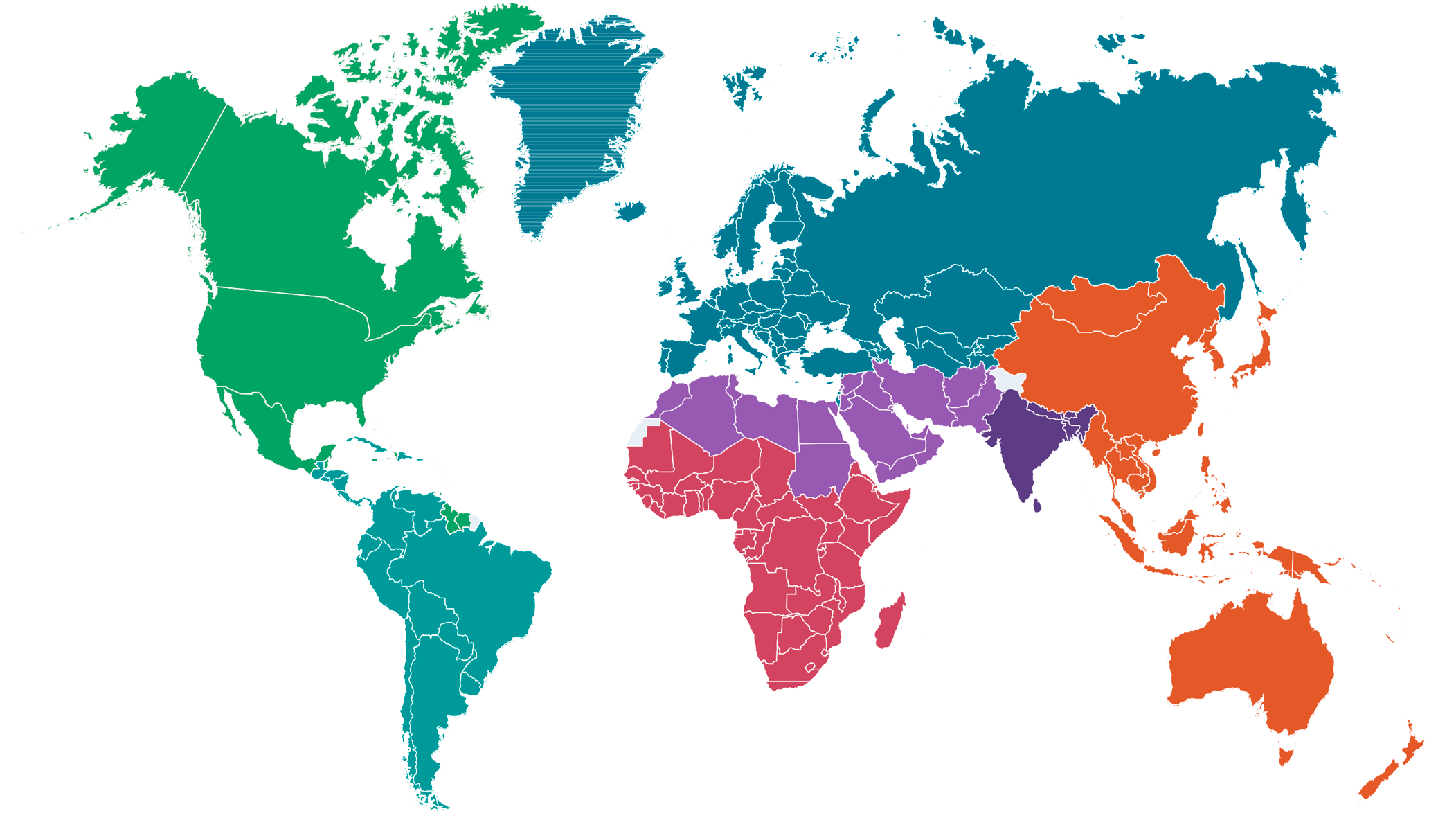

Highlights
- 589 million adults (20-79 years) are living with diabetes worldwide – 1 in 9.
- The total number of adults with diabetes is predicted to rise to 853 million by 2050 - 1 in 8.
- 4 in 5 adults with diabetes (81%) live in low and middle-income countries.
- Diabetes caused 3.4 million deaths in 2024 – 1 every 6 seconds.
- An estimated 43% of adults living with diabetes (252 million people) are undiagnosed. Almost 90% live in low and middle-income countries.
- Diabetes was responsible for an estimated USD 1.015 trillion in global health expenditure in 2024. This represents a 338% increase over the past 17 years.
- 635 million adults worldwide (1 in 8) have impaired glucose tolerance and 488 million have impaired fasting glucose (1 in 11) placing them at high risk of type 2 diabetes.
- 1 in 5 live births are affected by hyperglycaemia in pregnancy.

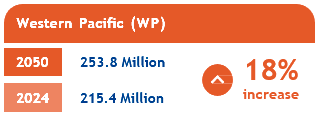
Table 3.1 Global estimates of key aspects of diabetes, intermediate hyperglycaemia, and hyperglycaemia in pregnancy in 2024 and 2050.
| At a glance | 2024 | 2050 |
| World Population | ||
| Total | 8.1 billion | 9.7 billion |
| Adults (20-79 years) | 5.3 billion | 6.6 billion |
| All diabetes (20–79 years) | ||
| Number of people with diabetes | 588.7 million | 852.5 million |
| Prevalencei | 11.1% | 13.0% |
| Number of deaths attributed to diabetes | 3.4 million | - |
| Total health expenditure due to diabetesii (2024 USD) | 1.015 trillion | 1.043 trillion |
| Type 1 diabetes | ||
| Number of people with type 1 diabetes (all age groups) | 9.2 million | |
| Number of people with type 1 diabetes (>20 years) | 1.8 million | |
| Intermediate Hyperglycaemia | ||
| Impaired glucose tolerance (20–79 years) | ||
| Number of people | 634.8 million | 846.5 million |
| Prevalencei | 12.0% | 12.9% |
| Impaired fasting glucose (20–79 years) | ||
| Number of people with impaired fasting glucose | 487.7 million | 647.5 million |
| Prevalencei | 9.2% | 9.8% |
| Hyperglycaemia in pregnancy (20–49 years) | ||
| Number of live births affected | 23 million | |
| Proportion of live births affected | 19.7% | |
iNational prevalence. Updated to reflect the country’s current age, sex and urbanisation structure.
iiHealth expenditure for people with diabetes is assumed to be on average two fold higher than people without diabetes
Table 3.2 Number of adults (20–79 years) with diabetes and diabetes prevalence for countries grouped by World Bank income classification, 2024 and 2050.
| At a glance | 2024 | 2050 | ||||
| World Bank income classification | Diabetes prevalencei (%) | Age- standardised diabetes prevalenceii (%) | Number of people with diabetes (millions) | Diabetes prevalencei (%) | Age- standardised diabetes prevalenceii (%) | Number of people with diabetes (millions) |
| World | 11.1 | 11.1 | 588.7 | 13.0 | 13.0 | 852.5 |
| High-income countries | 12.4 | 10.2 | 114.1 | 14.0 | 12.0 | 126.5 |
| Middle-income countries | 11.3 | 11.5 | 452.9 | 13.7 | 13.5 | 674.8 |
| Low-income countries | 6.1 | 7.5 | 21.8 | 6.8 | 8.2 | 51.2 |
iNational prevalence
iiPrevalence is standardised to world population for the respective year
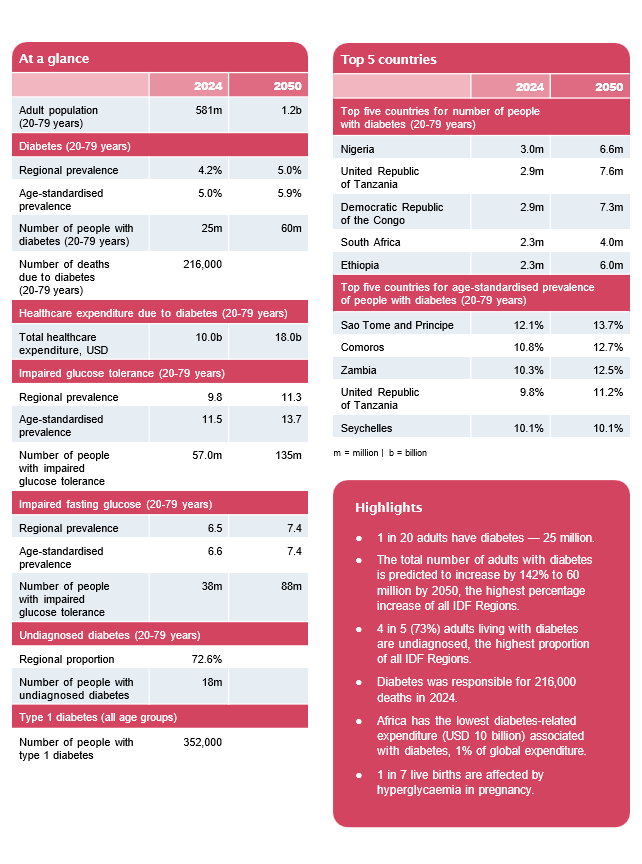
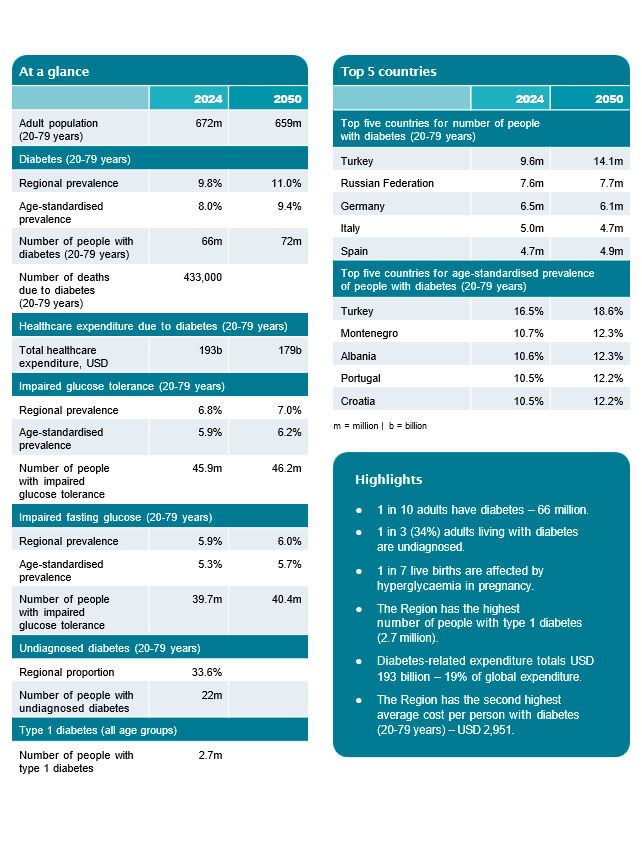
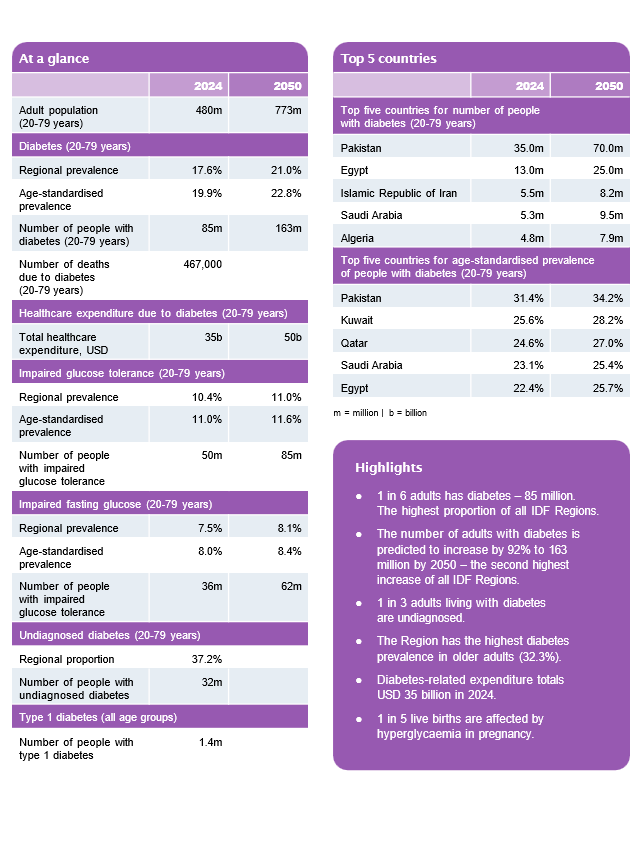
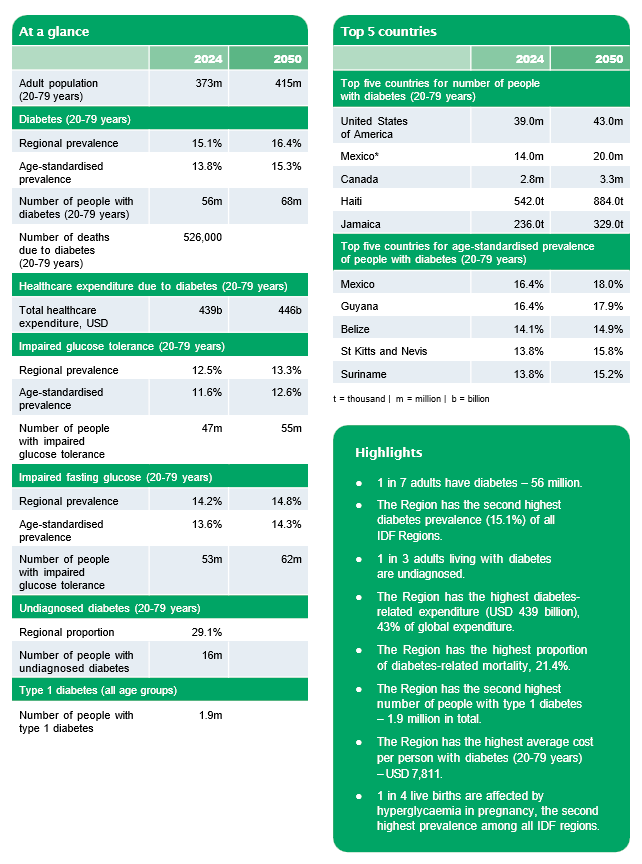
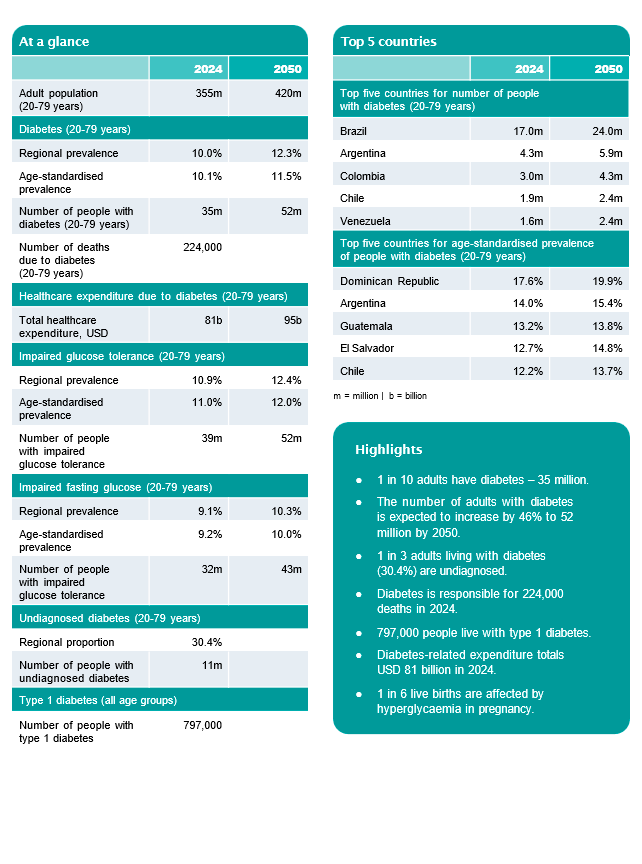
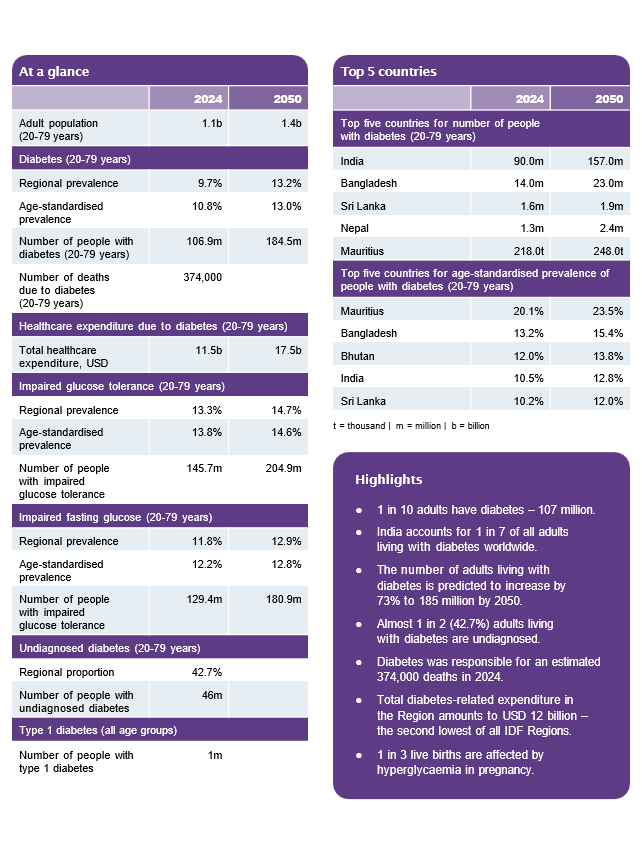

Projections show an increase in the expected prevalence of diabetes by 16% due to demographic aging of the population. The largest percentage increase in relative prevalence from 2021 to 2045 is estimated to occur in middle income countries. On the other hand, it is estimated that 94% of the increase in the number of people with diabetes by 2045 will be in low- and middle-income countries, where higher population growth is expected.
Gender distribution
Estimated prevalence of diabetes in women aged 20-79 years is slightly lower than in men (10.2% versus 10.8%). In 2021, there will be 17.7 million more men with diabetes than women.
PREVALENCE BY COUNTRIES
Countries with the highest number of adults with diabetes aged 20-79 in 2021 are China, India and Pakistan. They are expected to remain so in 2045.
Top 10 countries or territories by the number of adults (20-79 years old) with diabetes in 2021 and 2045.
| Position | Country | People with diabetes (million) | |
|---|---|---|---|
| 2021 | 2045 | ||
| 1 | China | 140.9 | 174.4 |
| 2 | India | 74.2 | 124.9 |
| 3 | Pakistan | 33.0 | 62.2 |
| 4 | USA | 32.2 | 36.3 |
| 5 | Indonesia | 19.5 | 28.6 |
| 6 | Brazil | 15.7 | 23.2 |
| 7 | Mexico | 14.1 | 22.3 |
| 8 | Bangladesh | 13.1 | 21.2 |
| 9 | Japan | 11.0 | 20.0 |
| 10 | Egypt | 10.9 | 13.4 |

PREVALENCE BY URBAN AND RURAL AREAS
In 2021, more people with diabetes lived in cities (360 million) than in rural areas (176.6 million), with the prevalence of 12.1% in cities and 8.3% in rural areas. The number of people with diabetes living in cities is expected to increase to 596.5 million in 2045 as a result of global urbanization. And also, up to 13.9% due to demographic aging of the population.
Estimates in the 10th edition of the IDF Diabetes Atlas are presented for 215 countries and territories grouped into seven IDF regions: Africa (AFR), Europe (EUR), Middle East and North Africa (MENA), North America and the Caribbean (NAC), South and Central America (SACA), Southeast Asia (SEA), and Western Pacific (WP). A total of 219 data sources from 144 countries were included in the analysis.
Number of adults (20-79 years old) with diabetes by World Bank Income Classification in 2021 and 2045
| Overview | 2021 | ||
|---|---|---|---|
| World Bank Income Classification | Number of people with diabetes (million) | Prevalence of diabetesi(%) | Comparative prevalence of diabetesii (%) |
| World | 536.6 | 10.5% | 9.8 |
| High income countries | 103.9 | 11.1% | 8.4 |
| Middle income countries | 414.0 | 10.8% | 10.5 |
| Low-income countries | 18.7 | 5.5% | 6.7 |
| Number of deaths from diabetes | 6.7 | — | |
| Overview | 2045 | ||
| World | 783.2 | 12.2% | 11.2 |
| High income countries | 117.7 | 12.4% | 10.3 |
| Middle income countries | 623.3 | 13.1% | 12.0 |
| Low-income countries | 42.2 | 6.1% | 7.0 |
| Number of deaths from diabetes | — | ||
| i - Prevalence is standardized for the population of each country for the respective year. | |||
| ii - Prevalence is standardized for the world population for the respective year. | |||
Projections show an increase in the expected prevalence of diabetes by 16% due to demographic aging of the population. The largest percentage increase in relative prevalence from 2021 to 2045 is estimated to occur in middle income countries. On the other hand, it is estimated that 94% of the increase in the number of people with diabetes by 2045 will be in low- and middle-income countries, where higher population growth is expected.
Gender distribution
Estimated prevalence of diabetes in women aged 20-79 years is slightly lower than in men (10.2% versus 10.8%). In 2021, there will be 17.7 million more men with diabetes than women.
PREVALENCE BY COUNTRIES
Countries with the highest number of adults with diabetes aged 20-79 in 2021 are China, India and Pakistan. They are expected to remain so in 2045.
Top 10 countries or territories by the number of adults (20-79 years old) with diabetes in 2021 and 2045.
| Position | Country | People with diabetes (million) | |
|---|---|---|---|
| 2021 | 2045 | ||
| 1 | China | 140.9 | 174.4 |
| 2 | India | 74.2 | 124.9 |
| 3 | Pakistan | 33.0 | 62.2 |
| 4 | USA | 32.2 | 36.3 |
| 5 | Indonesia | 19.5 | 28.6 |
| 6 | Brazil | 15.7 | 23.2 |
| 7 | Mexico | 14.1 | 22.3 |
| 8 | Bangladesh | 13.1 | 21.2 |
| 9 | Japan | 11.0 | 20.0 |
| 10 | Egypt | 10.9 | 13.4 |

PREVALENCE BY URBAN AND RURAL AREAS
In 2021, more people with diabetes lived in cities (360 million) than in rural areas (176.6 million), with the prevalence of 12.1% in cities and 8.3% in rural areas. The number of people with diabetes living in cities is expected to increase to 596.5 million in 2045 as a result of global urbanization. And also, up to 13.9% due to demographic aging of the population.
PREVALENCE OF DIABETES IN THE EUROPEAN REGION
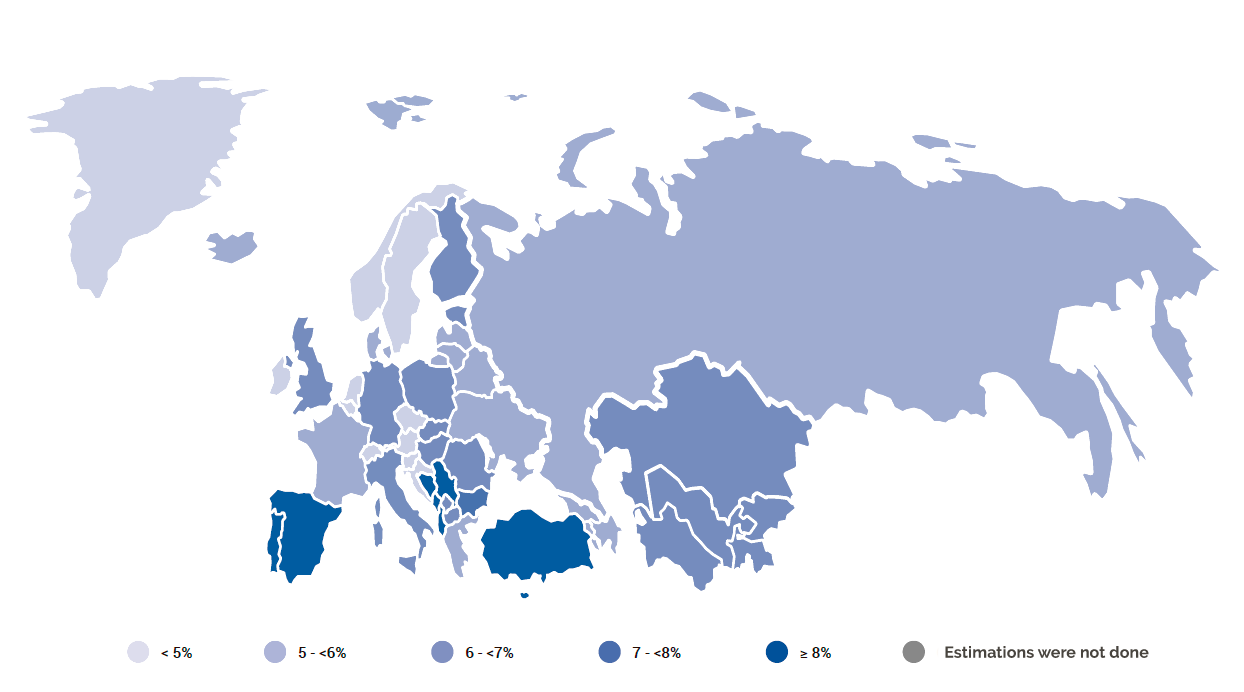
Comparative age-adjusted prevalence of diabetes (%) (20-79 years) in the IDF European Region in 2021
Estimates were made for 59 countries and territories in the IDF Europe (EUR) region. A total of 60 data sources from 39 countries were used to derive estimates of adult diabetes in the Region. The estimates for 14 countries (Austria, Denmark, Finland, France, Georgia, Greece, Greenland, Hungary, Lithuania, Malta, Russian Federation, Turkmenistan, United Kingdom, and Uzbekistan) were based on the surveys conducted over the past five years.
The IDF predicts that by 2045 prevalence of diabetes (9.2%) and the number of people with diabetes (61 million) in the European Region will increase by 13%. The European Region has the highest number of children and juveniles with type 1 diabetes (295 000). Moreover, there is the highest incidence every year – 31,000 new cases per year. The European Region ranks second in terms of the average cost of care per person with diabetes ($3,086). In 2021, US$189.3 billion was spent for combating diabetes, representing 19.6% of total spending worldwide.
| Overview | |||
|---|---|---|---|
| 2021 | 2030 | 2045 | |
| Adult population of Europe | |||
| Aged 20-79 years old | 670 million | 677 million | 668 million |
| Diabetes (20-79 years) | |||
| Regional prevalence | 9.2% | 9.8% | 10.4% |
| Comparative prevalence by age | 7.0% | 8.0% | 8.7% |
| Number of people with diabetes | 61 million | 67 million | 69 million |
| Number of deaths from diabetes | 111 100 | - | - |
| Health care costs due to diabetes (20-79 years) | |||
| Total healthcare spending, USD | 189.3 billion | 189.6 billion | 185.3 billion |
| Impaired glucose tolerance (20-79 years) | |||
| Regional prevalence | 8.2% | 8.3% | 8.3% |
| Comparative prevalence by age | 7.1% | 7.6% | 7.8% |
| Number of people with impaired glucose tolerance | 54.8 million | 56.1 million | 55.3 million |
| Impaired fasting glucose level (20-79 years) | |||
| Regional prevalence | 3.8% | 4.0% | 4.0% |
| Comparative prevalence by age | 3.3% | 3.5% | 3.7% |
| Number of people with impaired fasting glucose levels | 25.6 million | 26.8 million | 26.7 million |
| Undiagnosed diabetes (20-79 years old) | |||
| Regional prevalence | 35.7% | - | - |
| Number of people with undiagnosed diabetes | 21.9 million | - | - |
| Diabetes of Type 1 (0-19 years) | |||
| Number of children and adolescents with Type 1 diabetes | 249 900 | - | - |
| Number of newly diagnosed children and juveniles each year | 31 000 | - | - |
TOP 5 COUNTRIES
| Top 5 countries by age-adjusted prevalence of diabetes (20-79 years) | 2011 | 2021 |
|---|---|---|
| Turkey | 8.1% | 14.5% |
| Spain | 6.5% | 10.3% |
| Andorra i | 5.6% | 9.7% |
| Portugal | 9.8% | 9.1% |
| Serbia | 7.9% | 9.1% |
| i - based on the extrapolation of similar countries / mln.= million / bln.=billion |
| Top 5 countries by number of people with diabetes (20-79 years old) in millions | 2011 | 2021 |
|---|---|---|
| Turkey | 3.5 | 9 |
| Russian Federation | 12.6 | 7.4 |
| Germany | 5 | 6.2 |
| Spain | 2.8 | 5.1 |
| Italy | 3.6 | 4.5 |
Estimated prevalence (%) of diabetes by age and gender in the IDF European Region in 2021
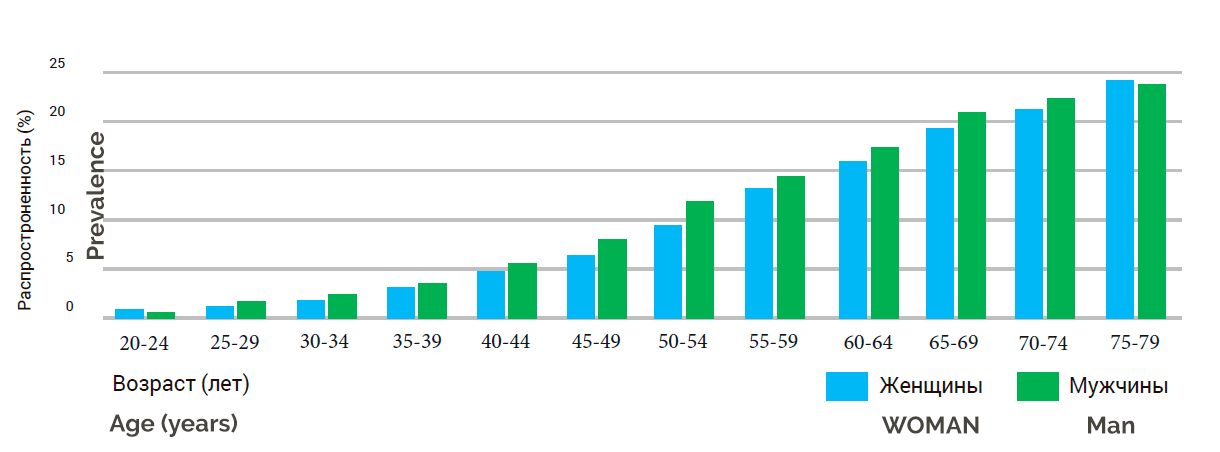
DEATH RATE FROM DIABETES
Diabetes is the main cause of death worldwide, although its impact varies by region. As estimated, 6.7 million adults aged 20 to 79 died as a result of diabetes or its complications in 2021. This corresponds to 12.2% of global deaths from all causes in this age group. Approximately one third (32.6%) of all deaths from diabetes occur in people of working age (under 60). This corresponds to 11.8% of the total number of deaths in the world among people under 60 years of age.
Number of diabetes deaths among adults (20-79 years old) by age and gender in 2021
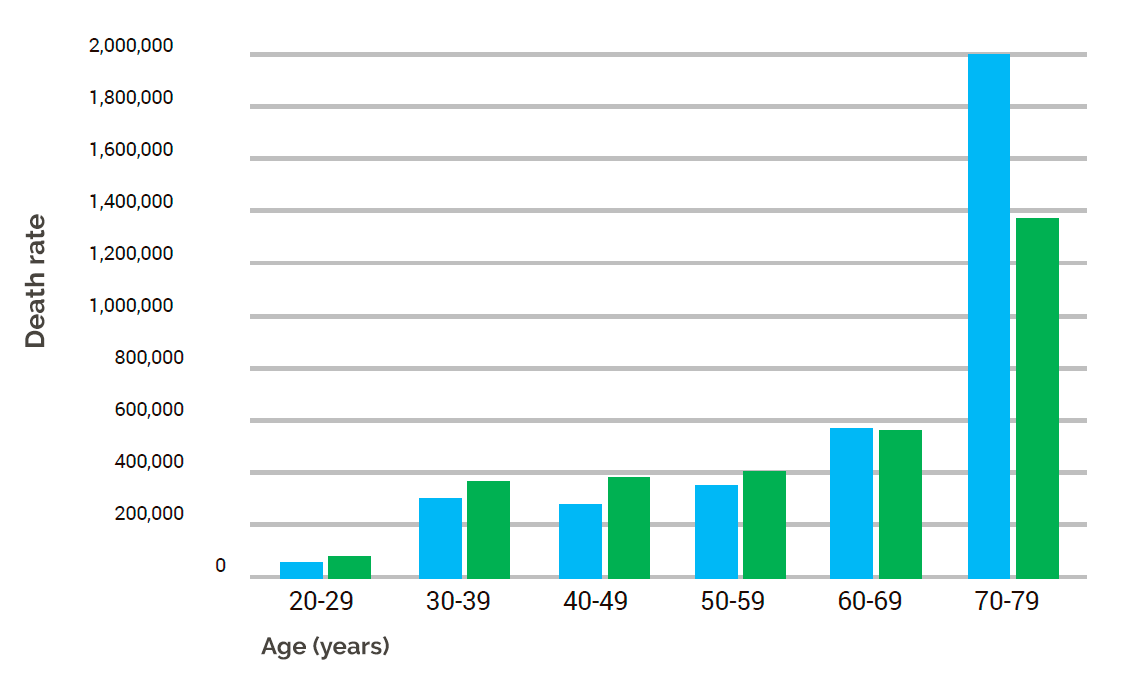
About 6.7 million adults (20-79 years) died from diabetes or its complications in 2021
PREVALENCE BY COUNTRIES
Partly due to its large population, China has the highest annual number of deaths from diabetes, of approximately 1.4 million. Due to its large population and high prevalence of diabetes, the US has the second highest number of deaths of 0.7 million. The next largest is India (0.6 million), followed by Pakistan (0.4 million) and Japan (0.2 million).
Countries with the highest proportion of total diabetes-related deaths are Singapore (29%) and Pakistan (29%). Followed by Israel (29%), Barbados (28%) and Italy (26%). Countries with the lowest proportions are Russia and the Czech Republic, each accounting for roughly 1% of total deaths.
Pakistan is the country with the highest proportion of deaths from diabetes under the age of 60 – 35.5%. It is followed by Singapore, Brunei and Kiribati with 31.4%, 31.3% and 30.4% respectively. This indicates a high burden of diabetes in the working-age population. Countries with the lowest proportion of deaths under the age of 60 are Benin and Slovakia (1.6%).

DIABETES IN THE REPUBLIC OF UZBEKISTAN
According to the data provided in the 10th edition of the IDF Diabetes Atlas in 2021, the number of people diagnosed with diabetes in Uzbekistan reached 1,351,800. The death rate of people with diabetes increased to 3% due to the situation with the COVID-19 pandemic.
The President of the Republic of Uzbekistan signed a number of documents and issued Presidential Decrees to combat diabetes:
- • The Decree of the President of the Republic of Uzbekistan dated December 18, 2018, No. PP-4063 “On measures to prevent non-communicable diseases, support a healthy lifestyle and increase the level of physical activity of the population”;
- • The Decree of the President of the Republic of Uzbekistan dated April 19, 2019, No. PP-4295 “On approval of the National Program for Improving Endocrinological Aid for the Population of the Republic for 2019-2021”;
- • The Decree of the President of the Republic of Uzbekistan dated January 26, 2022, No. PP-102 “On measures to improve and expand the scope of the endocrinological service”.
It is important to note that within the framework of the National Program for Improving Endocrinological Aid for the Population of the Republic for 2019-2021, new diagnostic and treatment standards have been approved. About 75 thousand patients are provided with insulin free of charge at the expense of the State budget, in the amount of over 40 billion Uzbek So’ms. The material and technical base of 14 regional endocrinological institutions has been strengthened in the amount of more than 200 billion Uzbek So’ms, and provided with modern equipment in the amount of 3.3 million US dollars.
In addition, within two months, the Pharmaceutical Industry Development Agency of the Republic of Uzbekistan took actions to expand activities of domestic manufacturers of special medicines in the field of endocrinology, as well as to establish the production of glucometers and special test strips in the Republic.
Significant work is done in the Republic of Uzbekistan to improve quality of treatment for patients with diabetes mellitus.


